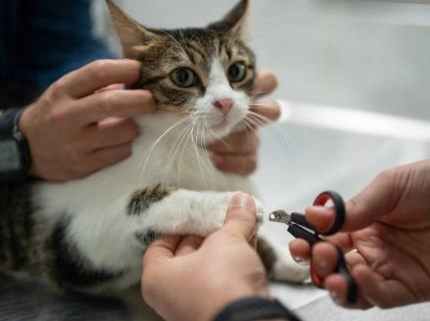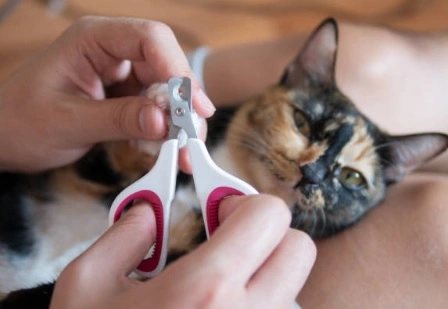As a cat owner, you may be considering declawing your cat to protect your furniture and belongings from scratching. However, declawing is an expensive procedure, with costs typically ranging from $100-$500 per cat paw. This can make the price tag unaffordable for many cat parents. You may be wondering, “Where can I declaw my cat for free or at a low cost?”
Exploring Where Can I Declaw My Cat For Free, low-cost cat declawing options, and effective no-cost alternatives like nail caps.
Where Can I Declaw My Cat For Free?
While free and low-cost declawing options are very limited, this article will explore some ways you may be able to reduce or eliminate fees.
We’ll review factors impacting the price of cat declawing, provide tips for finding discounts, and discuss free or lower-cost alternatives that protect your home without permanent surgery. My goal is to help you make an informed, budget-friendly decision that maintains both your cat’s health and your possessions.
Understanding the Base Costs of Feline Declawing Procedures
To determine how to reduce or eliminate declawing fees, it helps to first understand what goes into the basic cost:
Medical Supplies: Scalpels, sutures, bandages, surgical tools, and medicines average $50-$150 per paw declawed.
Anesthesia and Monitoring: General anesthesia and vitals monitoring during the surgery averages $30-$100+ per paw.
Hospital Care: At least one overnight stay for post-op monitoring costs $50-$150 on average.
Lab Tests and Pain Medication: Pre-surgery blood work, IV fluids, and take-home pain pills typically add $50-$200+ to the final cost.
The Surgery Itself: The declawing procedure fee ranges from about $50-$300 per paw.
Total: On average, cat owners pay $100-$500+ per paw for a total $400-$2000 to remove all claws, with fees varying by clinic.

As you can see, medications, medical supplies and aftercare represent a large portion of the declawing expense. The surgery and hospitalization costs are unavoidable if choosing this permanent procedure.
Ways to Seek Discounts on Cat Declawing
While cat declawing is rarely free, there are some ways you may be able to reduce the costs:
Negotiate with your vet: Politely discuss your financial constraints and ask if any discount can be offered on their fees or medication charges. Most vets aim to help within reason.
Inquire about payment plans: Many veterinary clinics offer interest-free monthly payment options to ease the burden.
Look for new vet promotions: Vets opening a new facility sometimes run declawing specials for client acquisition. Check ads from recently opened nearby clinics.
Consider clinics with lower overhead: Due to lower rent and staffing costs, subsidized spay/neuter clinics may offer declawing for 20%-50% less than private practices.
Investigate ASPCA or humane society clinics: In select areas, the ASPCA and humane societies operate low-cost or free spay/neuter clinics which sometimes include declawing.
SK about Rescue Group Vouchers: Local rescue groups may get donated or discounted service vouchers to distribute. It’s worth asking!
Schedule during “slow” months: Vet costs can dip from January-March when temporarily lower pet visits allow discounts.
While none of these options fully eliminate fees, they could potentially help reduce the total cost by a portion. However, cat declawing always involves significant expenses that are hard to avoid.
Free and Low-Cost Alternatives to Permanently Declawing Cats
Since cat declawing costs a substantial amount even when discounted, you may wish to consider these alternatives that protect your home at no to minimal cost:
Regular nail trims: Keeping your cat’s nails neatly trimmed reduces snags and damage during scratching. Ask your vet for guidance to avoid cutting the quick.
Cat scratching posts/pads: Provide appealing sisal, carpeted and cardboard scratchers around your home to redirect scratching off furniture.
Cat trees: Multi-level cat trees with scratching surfaces provide climbing, perching and scratching outlets.
Repellent sprays: Lightly mist furniture and off-limit areas with pet-safe citrus or pheromone sprays to deter scratching. Reapply as needed.
Double-sided tape: Attach layers of sticky double-sided tape to furniture edges and scratch-prone areas to discourage clawing when making contact.
Vinyl furniture covers: Shield couches, chairs and cushions with inexpensive vinyl covers to prevent upholstery damage when scratching.
Training: Use positive reinforcement like treats to shape scratching on approved surfaces instead of furniture. Offer praise and pets when they scratch properly.
Pheromone diffusers: Plug-in feline pheromone diffusers help calm stress that may manifest as destructive scratching.
Nail caps: Plastic nail caps applied with non-toxic glue slip over claws to prevent snagging but allow normal extension.

With patience and consistency, these humane alternatives can divert scratching off your valuables without surgically removing your cat’s claws. Protect your possessions while letting your cat keep their natural abilities.
Making the Best Choice for You and Your Cat
Ultimately, finding free or discounted declawing is very challenging due to the medical nature of the procedure. While some savings are possible, declawing always requires a substantial financial investment.
If cost is a concern, humane alternatives provide effective, cat-friendly solutions. However, evaluate your specific situation thoughtfully.
If declawing truly seems the only workable option for you and your cat, be proactive in researching ways to secure discounts from vets and clinics in your area. By understanding all the options and costs, you can make the best decision for your unique needs and budget.
Your cat relies on you to ensure their well being while also protecting your home. Prioritize their health and happiness while finding reasonable solutions.

